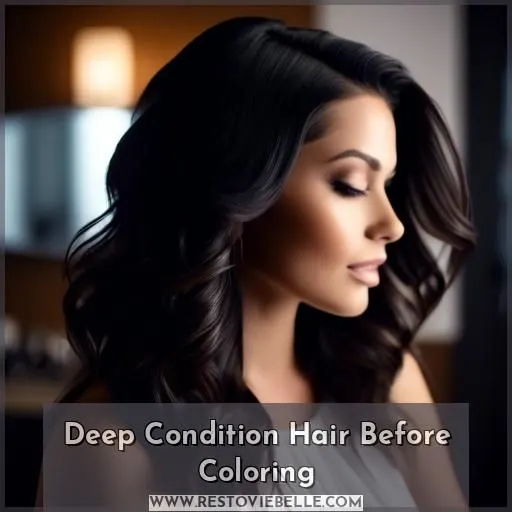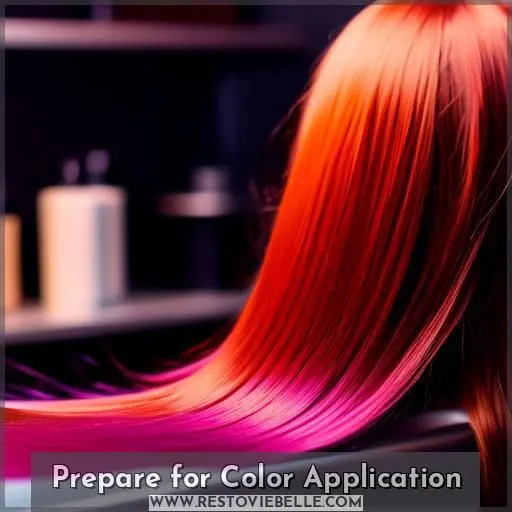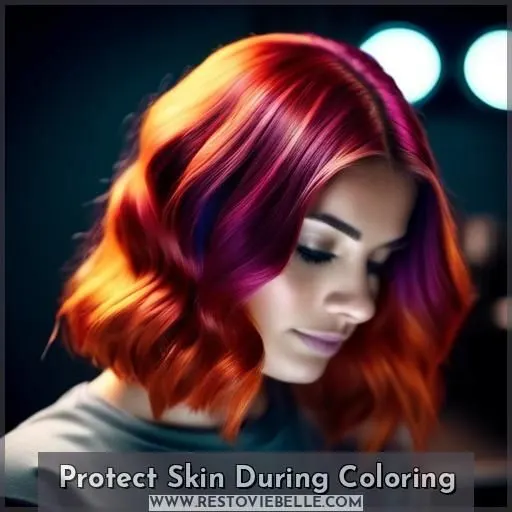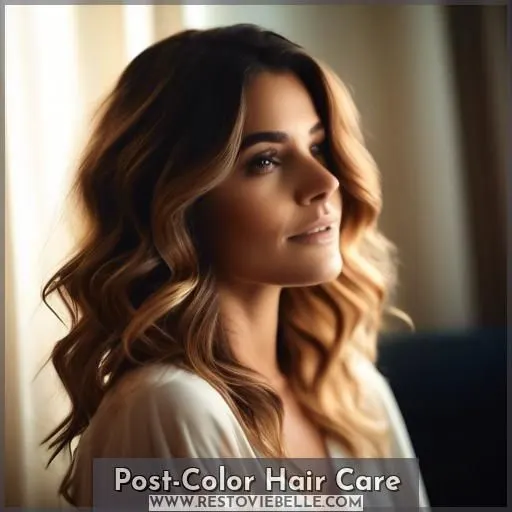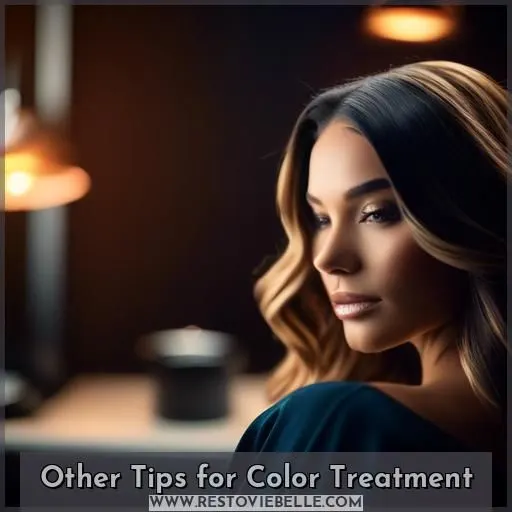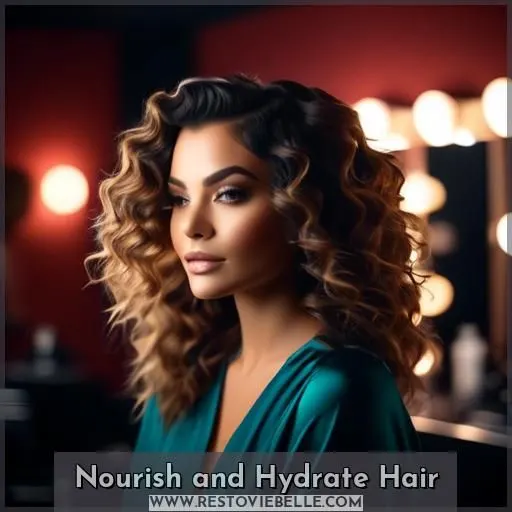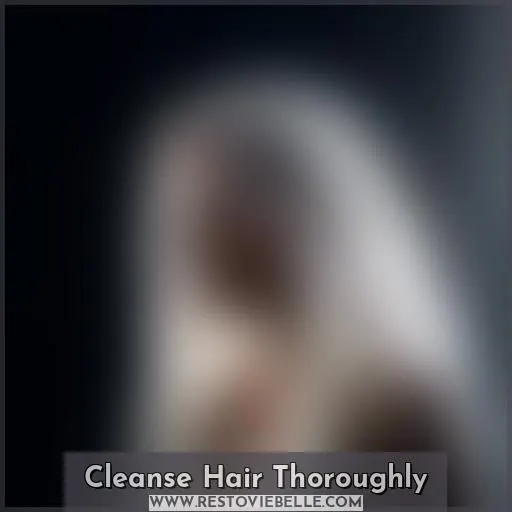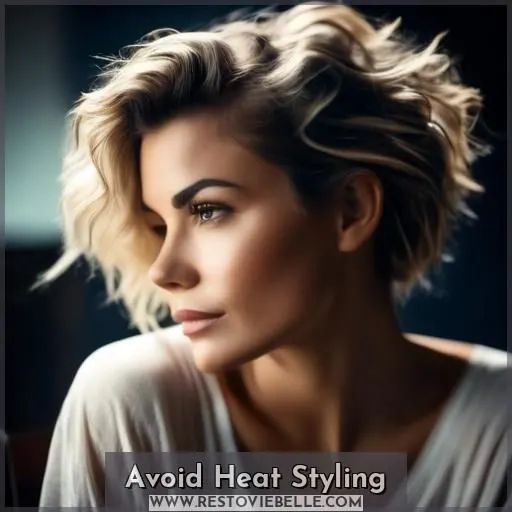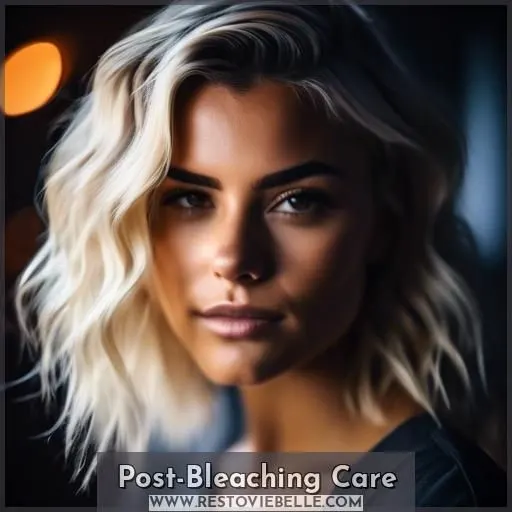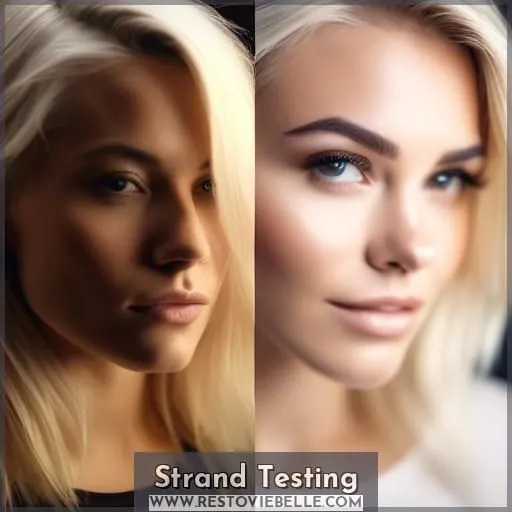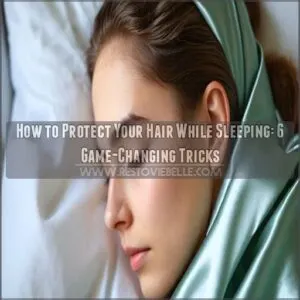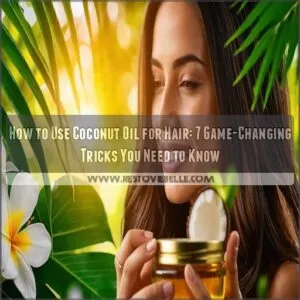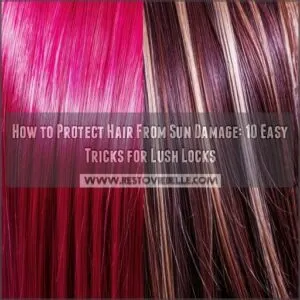This site is supported by our readers. We may earn a commission, at no cost to you, if you purchase through links.

Before you color your hair, it’s crucial to avoid conditioning it immediately before the dyeing process. Conditioning can leave a residue that hinders the dye’s ability to adhere effectively, resulting in uneven color or accelerated fading.
Instead, wash and condition your hair 24 to 48 hours prior to coloring to allow natural oils to safeguard your scalp and hair during the dyeing process.
After coloring, wait at least 48 to 72 hours before washing again, and then deeply condition to maintain moisture and color radiance.
By adhering to these steps, you’ll prepare your hair optimally for coloring, revealing the key to vibrant, enduring color.
Table Of Contents
- Key Takeaways
- Should I Condition My Hair Before Coloring?
- Deep Condition Hair Before Coloring
- Prepare for Color Application
- Protect Skin During Coloring
- Post-Color Hair Care
- Other Tips for Color Treatment
- Nourish and Hydrate Hair
- Cleanse Hair Thoroughly
- Avoid Heat Styling
- Post-Bleaching Care
- Strand Testing
- Frequently Asked Questions (FAQs)
- Conclusion
Key Takeaways
- Wash and condition hair 24 to 48 hours before coloring to allow natural oils to protect the scalp and hair during the dyeing process.
- Avoid using products, including conditioners and oils, before coloring as they can create a barrier that prevents the dye from adhering properly.
- Deep condition hair before coloring to restore moisture and protect the hair from damage during the coloring process.
- Wait at least 48 to 72 hours after coloring before washing again and then deeply condition to maintain moisture and color radiance.
Should I Condition My Hair Before Coloring?
Yes, you should condition your hair before coloring. The reason is that conditioning helps to soften and detangle the hair, making it easier to apply the color evenly. It also helps to protect the hair from damage during the coloring process.
However, it’s important to use a color-safe conditioner and to avoid using any conditioner on the day of the coloring appointment, as this can interfere with the color’s ability to penetrate the hair shaft.
Deep Condition Hair Before Coloring
To deep condition your hair before coloring, you should wash your hair three days before the coloring session, avoid using products, dust the ends to reduce frizz and split ends, and apply color to the ends last.
Wash Hair Three Days Before Coloring
To guarantee the optimal outcome when coloring your hair, it’s crucial to adhere to an appropriate hair washing routine. Here are four guidelines to assist you:
- Deep Condition Hair Before Coloring: A deep conditioning treatment can replenish moisture and safeguard your hair from harm during the coloring process.
- Avoid Using Products Before Coloring: Certain products can create a barrier that inhibits the color from bonding to your hair, so it’s advisable to steer clear of them before coloring.
- Dust Ends to Reduce Frizz and Split Ends: This simple technique can contribute to your hair looking healthier and more manageable after coloring.
Avoid Using Products Before Coloring
Before you apply hair color, it’s critical to avoid using any products on your hair. This includes styling products, conditioners, and even oils. The reason for this is that these products can create a barrier on your hair, preventing the color from adhering properly. Instead, you should focus on deeply conditioning your hair before coloring to ensure that it’s in the best possible condition for the coloring process.
You should wash your hair three days before you plan to color it and omit any conditioner, as semi-permanent colors condition hair. Additionally, you should remove any silicone buildup from your hair using a clarifying shampoo, as silicone can also prevent the color from adhering.
By following these steps, you’ll be able to achieve the optimal results when coloring your hair.
Dust Ends to Reduce Frizz and Split Ends
Dusting your hair ends can help eliminate frizz and reduce split ends before coloring. This simple hair care tip involves using a dry brush or your fingers to gently remove excess oils and product buildup from the ends of your hair. This process allows the natural oils to travel up the hair shaft, providing nourishment and preventing damage during the coloring process.
Deep conditioning your hair before coloring is also essential for maintaining hair health. It helps restore moisture and protect your hair from the damaging effects of coloring.
Additionally, using sulfate-free hair care products can help maintain the health of your hair by avoiding harsh chemicals that can strip your hair of natural oils and moisture.
Apply Color to Ends Last
After dusting those ends, remember, timing is everything when applying color. Touch up roots first, sparing the ends to minimize damage. This strategy maintains vibrancy, ensuring color penetration is even and your locks stay lusciously cared for.
Prepare for Color Application
Before dyeing your hair, it’s essential to prepare it adequately to guarantee optimal results. Here are some suggestions to consider:
- Avoid Ammonia-based Brands: Choose ammonia-free color brands for a milder treatment on your hair.
- Purchase Multiple Boxes: Acquire multiple boxes of color for comprehensive coverage, as some brands may necessitate more than one box for complete coverage.
- Apply Petroleum Jelly: Apply petroleum jelly along your hairline to prevent skin staining from the color.
- Color Roots Cautiously: Only color your roots if necessary, as excessive coloring can result in damage and dryness.
These steps will assist you in achieving a more uniform and durable color. Remember to follow the instructions on the color packaging and conduct a strand test before applying the color to your entire head.
Avoid Ammonia-based Brands for Gentler Treatment
To avoid harsh treatments and guarantee the well-being of your hair, consider opting for ammonia-based alternatives when choosing hair color products. Ammonia is commonly used in hair coloring to open up the cuticle, allowing pigment to penetrate the hair strands, but it can have negative impacts on hair health over time. Instead, look for hair color products that use alternative alkalizers, such as monoethanolamine (MEA), which can be less harmful to hair.
When selecting hair color products, consider the following:
- Professional hair color: Opt for professional hair color brands that prioritize the excellence of ingredients and their impact on the environment.
- Color-safe products: Make sure the hair color you choose is safe for your hair and won’t cause harm or irritation.
- Semi-permanent dyes: Choose semi-permanent dyes for a gentler treatment that doesn’t require the use of ammonia.
- Hair styling and treatment: Avoid heat styling and harsh chemicals, and use nourishing hair masks and treatments to maintain healthy hair.
Purchase Multiple Boxes of Color for Full Coverage
Purchase multiple boxes of color for complete coverage to guarantee even distribution of the hair dye. This will prevent uneven color saturation and ensure that your hair is completely covered, even in areas that are difficult to reach.
Additionally, using multiple boxes allows you to have extra product on hand in case you need to touch up any areas that may not have been fully covered during the initial application.
By following this tip, you can achieve a more vibrant and consistent color that will last longer.
Apply Vaseline Along Hairline to Prevent Skin Staining
To prevent skin staining while coloring your hair, apply Vaseline along your hairline before starting the coloring process. This creates a barrier that prevents the dye from penetrating your skin, avoiding any unwanted stains. Vaseline is an emollient that can protect your skin from the dye, ensuring a cleaner and more precise coloring experience.
Only Color Roots if Necessary to Avoid Drying Hair
To maintain root health and minimize scalp irritation, only dye roots when it’s required. This helps prevent dryness and ensures the dye absorbs effectively based on hair texture.
Protect Skin During Coloring
Wear gloves, preferably latex, to protect your skin during the coloring process. Avoid over-coloring to prevent damage to your hair. Deep condition your hair immediately after coloring to restore moisture and nourish your hair.
Wear Gloves, Preferably Latex
After preparing your locks, it’s essential to safeguard your skin. Don those gloves—latex or its replacements—to ward off allergies and prevent stains on your hands. This minor action is a significant step towards preserving your hair’s texture and well-being. Recall, timing is paramount; exercise patience, prioritize protection, then proceed with coloration.
Avoid Over-coloring to Prevent Damage
To help your hair color last and look vibrant, it’s essential to prevent over-coloring. Over-coloring can cause damage, uneven tone balance, and shortened color duration. Here are some tips to help you safeguard your hair color:
- Color Protection: Use antioxidant-rich shampoos and conditioners, like Wella Professionals ColorMotion+ Color Protection Shampoo and Conditioner, to shield your hair from color fading caused by free radicals.
- Root Coverage: If you have roots that need coloring, apply the color only to those areas to prevent over-coloring the rest of your hair.
- Hair Porosity: Understand your hair’s porosity level. Highly porous hair may require shorter coloring process times, while low-porosity hair may need longer processing times.
- Tone Balance: Maintain an even tone by using a pre-color treatment, like ColorMotion+ Pre-coloration Treatment, to seal the treatment before continuing with the coloring process.
- Deep Conditioning: Regularly deep condition your hair with a nourishing mask, like Color Motion+ Structure Mask, to keep your hair healthy and vibrant.
- Color-safe Products: Use color-safe shampoos and conditioners to protect your hair color from fading.
Deep Condition Hair Immediately After Coloring
Deep conditioning is essential post-coloring. Here’s how:
- Restore Moisture: Deep conditioning aids in restoring moisture lost during the coloring process.
- Damage Prevention: It safeguards hair from further harm and split ends.
- Color Protection: It closes the cuticle, securing color and deterring fading.
- Moisture Retention: Consistent deep conditioning maintains hair hydration, minimizing breakage and fostering growth.
Post-Color Hair Care
After coloring your hair, it’s imperative to deep condition it again to restore moisture and maintain vibrancy. Eschew heat styling or harsh chemicals, and trim split ends regularly to maintain healthy hair. Employing a hair mask once a week can also provide additional nourishment.
Deep Condition Hair Again After Coloring to Restore Moisture
Deep conditioning your hair after coloring is paramount to replenish moisture and avert damage. A deep conditioner is tailored to heal and nurture your hair, so it’s imperative to let it sit for a more extended period than your regular conditioner before rinsing. Deep conditioning aids in enhancing elasticity, which can prevent breakage, and imparts your hair with a natural luster.
To deep condition your hair effectively, adhere to these steps:
- Select the appropriate deep conditioner: Choose a product that aligns with your hair type and condition. If your hair is impaired, seek a protein-rich formula to facilitate strengthening and mending.
- Apply the deep conditioner: Apply a substantial amount of the product to your hair, concentrating on the ends, which are more vulnerable to damage.
- Leave it on: Based on the product’s instructions, leave the deep conditioner on for 10-30 minutes. For optimal results, cover your hair with a shower cap or plastic wrap to facilitate deeper penetration of the product.
- Rinse thoroughly: After the recommended duration, rinse your hair thoroughly with cool water to eliminate the deep conditioner.
- Repeat as necessary: If your hair is severely damaged or colored, you may need to deep condition more frequently.
Avoid Heat Styling or Harsh Chemicals
After coloring, deep condition your hair again to restore moisture. Use leave-in products or protective hairstyles to prevent damage and enhance color longevity. Avoid harsh chemicals and heat styling, as they can cause further damage to your hair. Remember, a little patience and care go a long way in maintaining your perfect color.
Trim Split Ends Regularly to Maintain Healthy Hair
Regularly trimming your hair is essential for maintaining healthy hair after coloring. Here’s how:
- Split End Repair: Trimming split ends prevents further damage and keeps your hair healthy.
- Prevent Split Ends: Regular trims can prevent split ends from forming, saving you from future repairs.
- Healthy Hair Maintenance: Trimming every 6-8 weeks helps keep your hair in prime condition, making coloring easier.
- Hair Health: By maintaining healthy hair, you’ll enjoy the benefits of your color treatment for longer.
Other Tips for Color Treatment
When considering hair color treatment, opt for semi-permanent or henna dyes as they’re less damaging to your hair. Always read and follow the instructions on the packaging, use color-safe shampoo and conditioner, and protect your hair from the sun to maintain the vibrancy of your color.
Consider Semi-permanent or Henna Dyes for Less Harsh Treatment
Considering your hair’s health and the potential damage that can come with harsh chemical treatments, semi-permanent or henna dyes can be a great option for less harsh treatment. Henna is known for its nourishing properties, which can help protect your hair from damage and promote hair growth. It also has antifungal and antimicrobial properties, which can improve the texture of your scalp and prevent irritation.
Semi-permanent dyes, on the other hand, are less damaging than permanent dyes because they don’t penetrate the hair shaft. They’re great for those with sensitive hair or for those who want to change their color without committing to a long-lasting change. However, they may need to be reapplied more frequently to maintain the color.
Read and Follow Instructions Carefully
- Patch Test
- Check if color is too light, dark, or ashy
- Test for scalp reaction to dye chemicals
- Skin Protection
- Wear gloves, preferably latex
- Apply Vaseline along hairline to prevent skin staining
- Use rubbing alcohol or nail polish remover to remove skin stains
- Color Application
- Apply color to ends last
- Use developer to lift hair color, but be cautious with damaged hair
- Avoid over-coloring to prevent damage
- Post-Color Hair Care
- Deep condition hair immediately after coloring
- Use a leave-in conditioner or hair serum to protect hair
- Avoid heat styling or harsh chemicals
- Trim split ends regularly to maintain healthy hair
- Consider using a hair mask once a week for extra nourishment
- Other Tips
- Consider semi-permanent or henna dyes for less harsh treatment
- Read and follow instructions carefully
- Do a patch test before applying color to the entire head
- Use a color-safe shampoo and conditioner
- Protect hair from sun exposure to prevent fading
Use a Color-safe Shampoo and Conditioner
To keep your color vibrant, switch to color-safe products for your post-color care routine. Toning shampoos can be a mane-changer, ensuring your hair maintenance doesn’t wash away your new hue.
| Color-Safe Shampoos | Benefits |
|---|---|
| Toning Shampoos | Neutralizes brassiness |
| Sulfate-Free | Prevents fading |
| Hydrating Formulas | Adds moisture |
| Protective Serums | Shields color |
| Natural Ingredients | Gentle care |
Protect Hair From Sun Exposure to Prevent Fading
To preserve your color and prevent fading, protect your hair from sun damage. Use UV-protective hair products, wear hats, and avoid prolonged sun exposure. Remember, sun damage can lead to color loss and overall hair damage.
Nourish and Hydrate Hair
To nourish and hydrate your hair before coloring, it’s recommended to use hair masques to provide hydration and nourishment. Additionally, it’s advised to wait a few days after treatment before coloring to allow the hair to recover. This will help maintain the vibrancy of the color and prevent damage.
Use Hair Masques to Hydrate and Nourish Hair
After investigating the multitude of color treatment suggestions, let’s delve into the essence of pre-color preparation: employing hair masques. These are your concealed implements for intensive conditioning and sustenance. Regardless of whether you’re crafting a handmade mask or acquiring suggested products, the aim is to pamper your tresses with affection.
| DIY Masks | Product Recommendations |
|---|---|
| Avocado & Honey | SheaMoisture Intensive Hydration |
| Banana & Olive Oil | Briogeo Don’t Despair, Repair! |
| Egg Yolk & Coconut Oil | Olaplex No. 8 Bond Intense Moisture |
Wait a Few Days After Treatment Before Coloring
Waiting a few days after treatment before coloring your hair is essential for nourishment and hydration. Here’s why:
- Hair Masques: Apply masques to replenish and nourish your hair, preparing it for color.
- Damage Prevention: Allowing your hair to rest before coloring helps avert damage from harsh chemicals.
- Color Care: Deep conditioning and hydration methods guarantee your hair is in the best condition for coloring.
- Consistency: Regularly applying masques and waiting between treatments maintains healthy hair.
Cleanse Hair Thoroughly
Before coloring your hair, it’s essential to cleanse it thoroughly. Shampoo your hair thoroughly before dyeing, but omit conditioner as semi-permanent colors condition hair. Remove silicone buildup with a clarifying shampoo to make sure the dye adheres well to your hair.
Shampoo Thoroughly Before Dyeing
Washing your hair thoroughly before dyeing is essential for a successful color application. This step guarantees that your scalp is clean and free of any oils or buildup that might interfere with the color’s adherence. It also aids in reducing the risk of skin irritation or scalp sensitivity.
Scheduling your product application is vital, as using the appropriate shampoo at the appropriate time can boost the color selection process and encourage hair follicle health.
Omit Conditioner, as Semi-permanent Colors Condition Hair
Regarding hair coloring, semi-permanent dyes provide a milder alternative to permanent ones. They don’t penetrate the hair shaft as deeply, resulting in less damage to your strands. However, this also means they lack the conditioning effects of a traditional conditioner. Instead, prior to dyeing, shampoo thoroughly to cleanse your hair and facilitate proper dye adherence.
Remove Silicone Buildup With Clarifying Shampoo
Before coloring your hair, it’s essential to eliminate any silicone buildup that may have accumulated from your hair care products. Silicones create a barrier on the hair surface, preventing it from absorbing water, air, and nutrients, which can lead to dryness, brittleness, and breakage. To remove this buildup, use a clarifying shampoo that’s specifically designed to eliminate silicones. This step is particularly important for those with fine, delicate hair types like Type A, as silicone buildup can weigh down the hair and make it difficult to manage and style.
After coloring your hair, continue to use hair masks and other nourishing treatments to maintain the health and hydration of your hair. If you’re concerned about the potential damage from silicones, consider using demi-permanent hair color, which fades with each shampoo and enhances your natural color. Remember to follow the instructions carefully and perform a patch test before applying color to your entire head.
Avoid Heat Styling
Essential for preserving the health and longevity of your color-treated hair is to avoid heat styling. Excessive heat styling can worsen heat damage, hair breakage, color fading, scalp irritation, and dryness.
Instead, embrace your hair’s natural texture, or choose air-drying methods like sea salt spray or finishing cremes.
Post-Bleaching Care
If you’ve just bleached your hair, hold off on coloring for at least 2-3 days to let your strands recover. During this time, pamper your hair with masks or restorative treatments to make sure it’s in the best shape for the new color.
Wait 2-3 Days After Bleaching Before Coloring
Wait 2-3 days after bleaching before coloring to give your hair time to recover from bleach damage. This allows for better color correction and hair repair.
When selecting a color, consider the level of damage and choose a dye that suits your hair’s condition.
Deep condition hair and use a color-safe shampoo and conditioner to maintain color.
Use Masques or Repairing Treatments to Restore Hair Health
To restore hair health after bleaching, it’s essential to incorporate masques or repairing treatments into your hair care routine. These products are designed to penetrate deep into the hair strands, providing nourishment and protection. They can be particularly beneficial for those with damaged hair, as they help to repair and strengthen the hair fibers from within.
When choosing a hair masque or treatment, consider the timing of application. It’s best to apply these products after shampooing and before conditioning, ideally while the hair and scalp are still warm. This allows the active ingredients to penetrate the hair more effectively.
It’s also important to test the color before applying it to your entire head. This can help you determine if the color is too light, dark, or ashy, and if it will cause any adverse reactions on your scalp. Always follow the manufacturer’s instructions carefully and perform a patch test before using the product on your entire head.
Strand Testing
Before coloring your hair, it’s crucial to perform a strand test to guarantee the most optimal results and avert possible problems. This test can aid in determining if the color is overly light, dark, or ashy, and if there are any indications of damage or uneven color. It also enables you to check for any allergic reactions to the dye chemicals.
A strand test entails taking a tiny portion of hair from an inconspicuous area and applying the color or bleach to it. You can then scrutinize the results after the prescribed processing time. By performing a strand test, you can modify the formula, processing time, or technique as necessary, ensuring a satisfactory outcome and preserving the health and integrity of your hair.
Check if Color is Too Light, Dark, or Ashy
When it comes to hair color, the shade you select can have a significant impact on your appearance and self-perception. To ensure you obtain the ideal color for your hair, conducting a strand test is crucial. This straightforward procedure entails applying a small amount of color to a concealed strand of hair to assess its appearance before committing to the entire color treatment.
The shade of your hair can be influenced by your complexion. For example, if you have fair skin and eyes, lighter shades may be more becoming. Conversely, if your skin is darker, deeper shades might be more appropriate. Remember that your skin tone can have cool, warm, or neutral undertones, which can affect how the color appears on your hair.
To perform a strand test, follow these steps:
- Trim a small section of hair that isn’t readily noticeable, such as a strand hidden beneath the top layer of hair.
- Mix a small amount of the hair product you intend to use for the service, such as hair dye or perm solution, as directed by the manufacturer’s instructions.
- Apply the product to the chosen strand of hair, ensuring even saturation.
- Leave the product on the hair for the recommended processing time.
- Rinse the hair with water and shampoo to remove the product.
- Examine the strand test results carefully, noting any signs of damage, uneven color, or texture issues.
- If the results meet your expectations, proceed with the complete service. If the results deviate from your expectations, adjust the product, processing time, or technique, and conduct another strand test until you achieve the desired outcome.
Test for Scalp Reaction to Dye Chemicals
Before applying hair dye, it’s essential to test the color on a small strand to confirm it’s the desired shade and to verify any allergic reactions. This process is known as a strand test. A strand test can help you evade unpleasant surprises and potential allergic reactions, which can range from minor irritation to severe reactions like contact dermatitis or even anaphylaxis.
To perform a strand test:
- Choose a small, concealed strand of hair, such as a strand near your ear or the back of your head.
- Apply a small amount of dye to the strand, adhering to the manufacturer’s instructions.
- Leave the dye on for the recommended processing time.
- Rinse the hair with water and shampoo to remove the dye.
- Observe the strand test results carefully, looking for any signs of damage, uneven color, or texture issues.
If the results are satisfactory, proceed with the complete service. If the results differ from what you expected, adjust the product, processing time, or technique, and perform another strand test until you achieve the desired outcome.
Frequently Asked Questions (FAQs)
Should I wash my hair before coloring?
It is recommended to wash and condition your hair 24 to 48 hours before coloring to allow enough time for the natural oils to return to your scalp and hair, providing protection during the coloring process.
How long should I wait after bleaching before coloring?
You’ve just bleached your hair, and it’s screaming for color like a desert thirsts for rain. Wait a mere 2-3 days, pamper it with some TLC, and then plunge into that dye!
Is it necessary to deep condition my hair before coloring?
Yes, it’s necessary to deep condition your hair before coloring. Deep conditioning helps to smooth the shaft of your hair, restore moisture, and prevent breakage caused by the coloring process. It also helps to improve the elasticity of your hair, making it less prone to damage. By deep conditioning your hair, you can guarantee that it’s in the best possible condition before coloring, which can help to prevent damage and maintain the vibrancy of the color.
Deep conditioning your hair before coloring is crucial. It smooths the hair shaft, restores moisture, and prevents breakage from the coloring process. Additionally, it improves hair elasticity, making it less susceptible to damage. By deep conditioning, you can ensure your hair is in optimal condition before coloring, which helps prevent damage and preserve the color’s vibrancy.
Can I use silicone-based products before coloring?
Silicones are commonly employed in hair formulations to enhance the texture and smoothness of hair, minimize frizziness, and impart a silky sheen. However, with extended use, they can accumulate on the hair, resulting in a dry sensation and a lackluster appearance.
To mitigate this, it’s advisable to utilize a shampoo that’s dissolvable in silicones, which helps minimize accumulation on the scalp and strands. Furthermore, nourishing the roots with regular natural oils can aid in preventing the detrimental effects of silicones on hair.
How often should I trim my hair after coloring?
To answer your question about how often you should trim your hair after coloring, it’s recommended to get a trim every six to 12 weeks, depending on your hair type and the frequency of coloring, heat styling, or chemical processing. This is because split ends can travel up the hair fiber, causing damage and the need for a shorter cut.
Regular trims can help eliminate split ends, allowing hair to grow longer and healthier.
Conclusion
Preparing your hair for coloring is essential for achieving vivid and enduring results. To guarantee maximum color absorption, cleanse and moisturize your hair 24 to 48 hours prior to coloring. After dyeing, allow at least 48 to 72 hours before washing again and deeply condition to preserve hydration and shine. By adhering to these steps, you’ll embark on a seamless color transformation.
